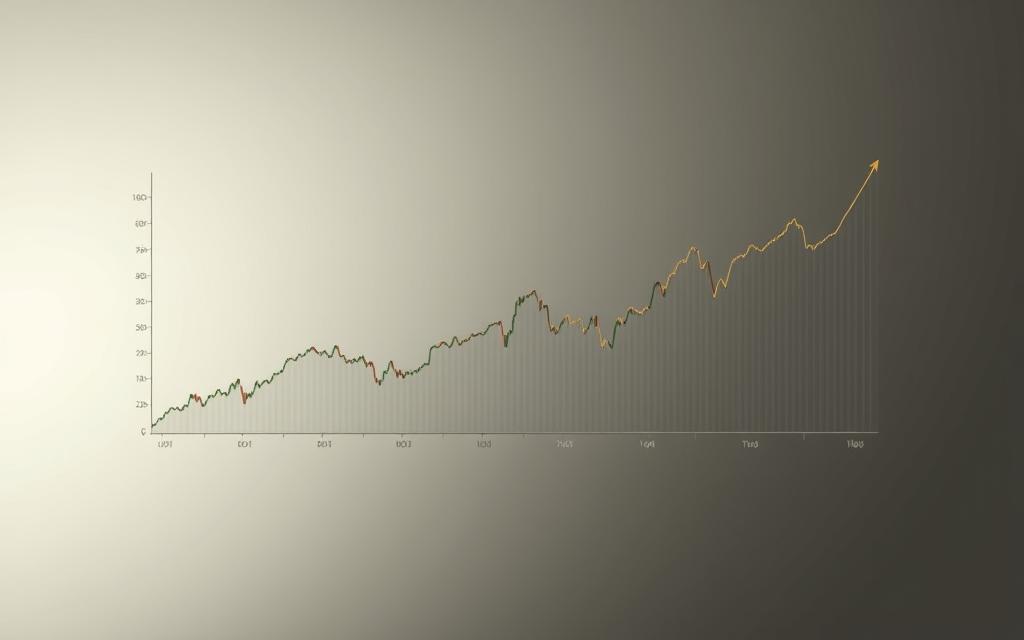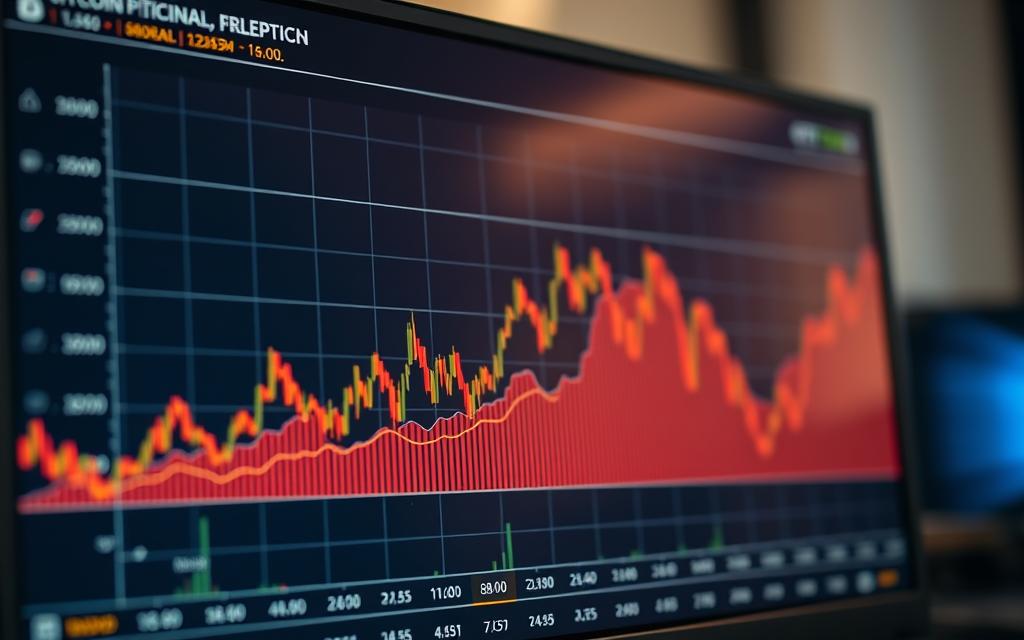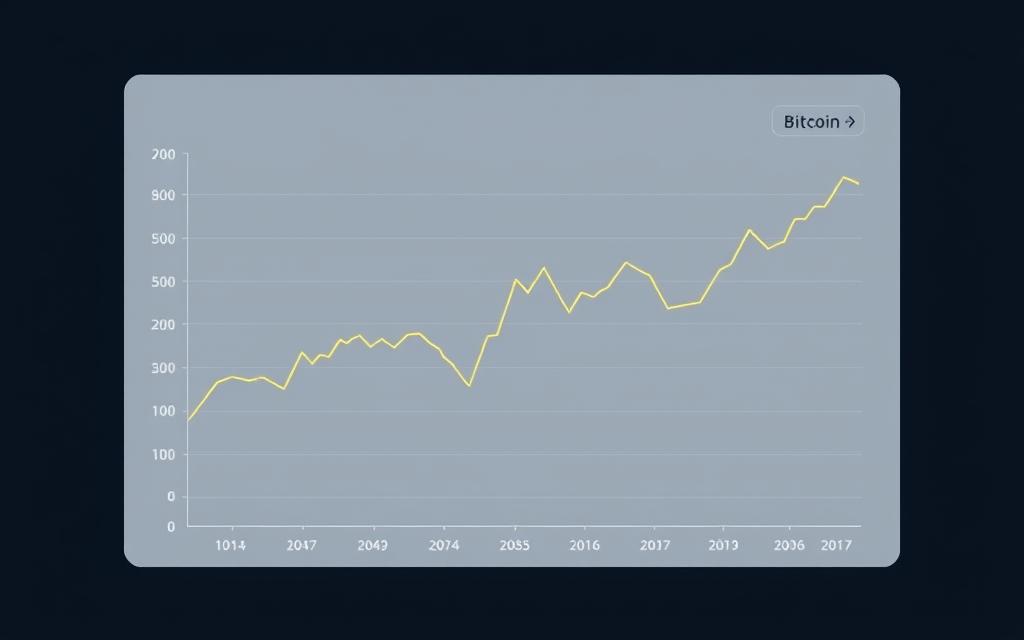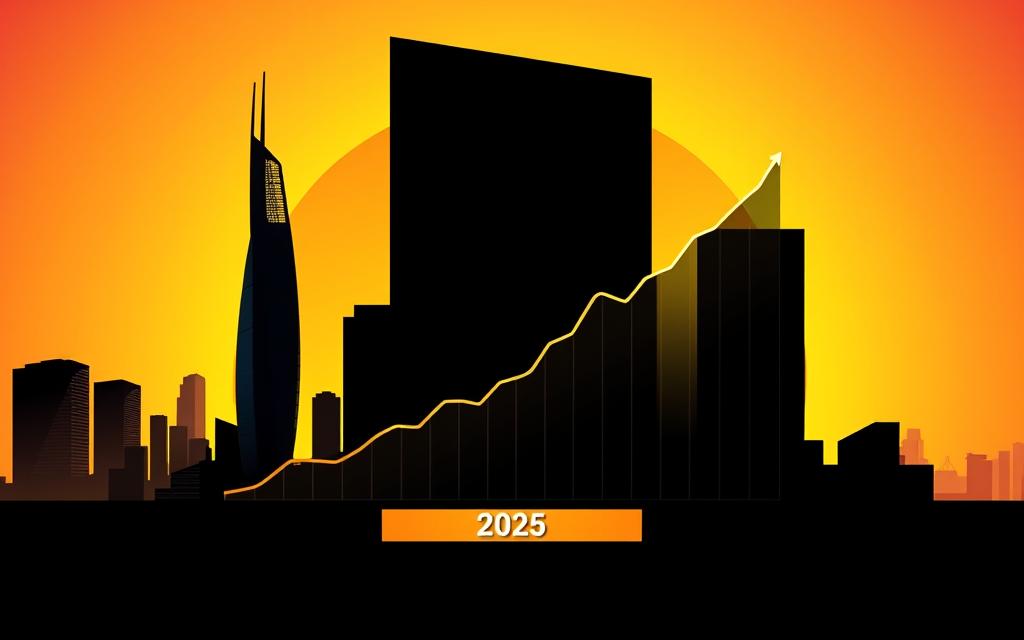Table of Contents
The cryptocurrency market has witnessed a significant surge, with Bitcoin’s price shattering its previous record and soaring past $111,000 for the first time in history.
This milestone is attributed to growing adoption from corporations, positive regulatory developments, and improving global economic conditions, creating a perfect storm for Bitcoin’s ascent.
As trading volumes and market capitalization figures illustrate, this rally is significant, with analysts and financial institutions providing insights into future price predictions.
The current market cycle is potentially different from past ones, driven by increased institutional investment and a shift in the global financial landscape.
The Current State of Bitcoin’s Price
Bitcoin’s current price status is a reflection of the broader crypto market’s dynamics. As of November 13, 2024, the global crypto market capitalization stands at $2.94 trillion, with a 0.57% increase over the last day. The total crypto market volume over 24 hours is $349.04 billion, marking a 31.22% increase.
Recent All-Time Highs and Price Movements
Bitcoin’s price has surged to unprecedented levels, driven by various factors including increased institutional adoption and retail interest. The cryptocurrency has seen significant price movements, with its price closely linked to the overall market sentiment and trading volume.
Market Capitalization and Trading Volume
The relationship between Bitcoin’s price movements and changes in trading volume is a key indicator of market strength. As trading volumes exceed $349 billion across the crypto market, it indicates strong market participation and liquidity.
| Indicator | Value | Change |
|---|---|---|
| Global Crypto Market Capitalization | $2.94 trillion | 0.57% increase |
| 24-hour Crypto Market Volume | $349.04 billion | 31.22% increase |
The surge in Bitcoin’s market capitalization and the substantial increase in trading volumes are indicative of a robust market. As investors continue to participate in the market, the dynamics between Bitcoin and other cryptocurrencies will be crucial in determining the future price movements.
Why Did Bitcoin Go Up? Key Driving Factors
Bitcoin’s price has seen a significant rise recently, driven by a combination of institutional adoption and retail interest. Understanding these factors is crucial for investors looking to navigate the cryptocurrency market.
Institutional Adoption and Investment
Institutional investment has played a pivotal role in Bitcoin’s recent price surge. The introduction of Bitcoin ETFs has made it easier for institutional investors to gain exposure to the cryptocurrency, leading to increased demand and, consequently, higher prices. According to recent data, the trading volume of Bitcoin ETFs has seen a significant uptick, indicating growing institutional interest.
| Institutional Investment Vehicle | Trading Volume | Change |
|---|---|---|
| Bitcoin ETFs | $1.2B | +20% |
| Bitcoin Futures | $2.5B | +15% |
The increased participation of institutional investors has not only driven up the price but has also contributed to the maturation of the cryptocurrency market. As more institutional money flows into Bitcoin, it is likely to continue to reduce volatility and attract even more investors.
Retail Interest and Market Sentiment
Alongside institutional adoption, retail interest in Bitcoin has also seen a resurgence. Social media platforms like Twitter, Reddit, and TikTok have played a significant role in shaping retail sentiment. The increased activity on these platforms has served as a barometer for retail interest and potential market entry points.

The Crypto Fear & Greed Index currently sits at 72 out of 100, indicating “greed” but still below the extreme levels seen at previous market tops. This suggests that while the market is optimistic, there is still room for further upside. On-chain data shows decreased selling pressure, with fewer Bitcoin inflows to exchanges, indicating a preference for holding rather than trading.
“The current market sentiment is a mix of optimism and caution, reflecting the complex dynamics at play in the cryptocurrency market.” – Crypto Market Analyst
Retail trading patterns have evolved, with a growing use of derivatives and leverage among individual investors. This shift has implications for market volatility and investor risk. Understanding these dynamics is crucial for making informed investment decisions.
The Role of Bitcoin ETFs in Price Surge
Bitcoin’s recent price surge can be attributed, in part, to the emergence of spot Bitcoin ETFs. The introduction of these financial instruments has fundamentally altered market dynamics by creating a consistent and predictable source of demand that differs from the speculative patterns seen in previous market cycles.
Record ETF Inflows and Their Impact
The influx of capital into Bitcoin ETFs has been remarkable, with record inflows contributing significantly to the cryptocurrency’s price surge. According to Julia Zhou, COO of crypto market maker Caladan, “Unlike previous cycles, this rally is not momentum-driven alone; it is quantitatively underpinned by measurable, persistent demand and supply dislocations.” The consistent demand created by ETFs has:
- Improved market efficiency by narrowing the gap between Bitcoin’s spot price and futures prices
- Enhanced market liquidity and depth, making it easier for large institutions to enter and exit positions
- Contributed to the professionalization of the Bitcoin market, with improved research coverage and investment frameworks
How ETFs Changed Market Dynamics
The presence of ETFs has also affected Bitcoin’s correlation with traditional financial markets. As institutional investors increasingly view Bitcoin as part of a diversified portfolio, its relationship with equities and bonds has evolved. ETFs have changed the way investors interact with Bitcoin, providing a more traditional and accessible investment vehicle. This shift has:
- Altered the way ETF-related Bitcoin purchases differ from direct market buying
- Impacted exchange order books and price discovery mechanisms
- Contributed to a more mature market with improved analysis and investment frameworks
The overall impact of Bitcoin ETFs on the cryptocurrency market has been profound, providing a new avenue for investment and changing the dynamics of the market. As the market continues to evolve, it will be interesting to see how ETFs continue to influence Bitcoin’s price and market dynamics.
Corporate Treasury Investments Fueling Bitcoin’s Rise
Corporate adoption of Bitcoin as a treasury asset has gained significant momentum, contributing to the cryptocurrency’s recent price surge. This trend is led by companies like MicroStrategy, which has expanded its Bitcoin holdings to over $50 billion. Other companies, such as Japan’s Metaplanet, have also made significant investments, with Metaplanet adding 1,004 BTC worth $129 million to its reserves.
Major Companies Adding Bitcoin to Balance Sheets
Several major companies have joined the trend of adding Bitcoin to their balance sheets. Twenty One Capital, backed by Tether and SoftBank, has launched a Bitcoin-focused treasury model. Additionally, several small-cap companies are financing Bitcoin purchases through convertible bonds and preferred stocks. This growing corporate interest in Bitcoin is a significant factor in its recent price appreciation.

The trend is driven by the strategic benefits of holding Bitcoin as a treasury asset, including protection against currency debasement and potential appreciation of reserves.
Strategic Benefits of Corporate Bitcoin Holdings
Companies adopting Bitcoin as a treasury asset cite several strategic benefits. These include protection against currency debasement, potential appreciation of reserves, and diversification away from traditional financial assets. For multinational corporations, Bitcoin offers a potential hedge against currency exchange risks and a way to maintain value across different economic environments and jurisdictions.
The asymmetric return profile of Bitcoin, with limited downside and significant upside potential, makes it an attractive allocation for corporate treasuries seeking to optimize risk-adjusted returns. As more companies adopt Bitcoin as a treasury asset, it creates a virtuous cycle, lending additional legitimacy to the cryptocurrency and potentially inspiring other companies to follow suit.
Macroeconomic Factors Behind Bitcoin’s Surge
The recent surge in Bitcoin’s price can be attributed to a combination of macroeconomic factors that have created a favorable environment for the cryptocurrency.
Federal Reserve Policies and Interest Rates
The Federal Reserve’s monetary policies, including interest rate decisions, have significantly impacted Bitcoin’s price. When interest rates are low, investors are more likely to invest in riskier assets like cryptocurrencies, driving up demand and price. Low interest rates have made borrowing cheaper, allowing investors to take on more risk and invest in Bitcoin.
As the Federal Reserve adjusts interest rates in response to economic conditions, it influences the overall liquidity in the financial system, which in turn affects Bitcoin’s price. The relationship between interest rates and Bitcoin’s price is complex and influenced by various factors, including inflation expectations and economic growth.
Inflation Concerns and Bitcoin as a Hedge
Inflation concerns have been rising due to expansive monetary policies and supply chain disruptions, leading investors to seek hedges against inflation. Bitcoin, with its limited supply and decentralized nature, has emerged as a potential hedge against inflation. Investors view Bitcoin as a store of value that can protect their wealth from the eroding effects of inflation.
The narrative around Bitcoin as a hedge against inflation has gained traction, with some investors comparing it to gold.
“Bitcoin is a hedge against the broad monetary and fiscal policies that are being implemented around the world.”
Dollar Weakness and Its Relationship to Bitcoin
Weakness in the U.S. dollar has made Bitcoin more attractive as a hedge against currency devaluation. The U.S. dollar’s performance against other major currencies has shown an inverse relationship with Bitcoin’s price, with periods of dollar weakness often coinciding with Bitcoin strength. 
The inverse relationship between the U.S. Dollar Index (DXY) and Bitcoin’s price movements suggests that a weaker dollar is conducive to higher Bitcoin prices. As the dollar weakens, investors may turn to Bitcoin as an alternative store of value, driving up its price.
In conclusion, the macroeconomic factors driving Bitcoin’s surge are multifaceted, involving Federal Reserve policies, inflation concerns, and dollar weakness. Understanding these factors is crucial for investors looking to navigate the cryptocurrency market.
Technical Analysis of Bitcoin’s Price Movement
Technical analysts are employing various tools to understand Bitcoin’s price action, including chart patterns and technical indicators. The recent surge in Bitcoin’s price has been accompanied by several bullish signals, making it crucial to analyze these technical indicators to predict future price movements.
Key Support and Resistance Levels
Bitcoin’s price history shows several key support and resistance levels that have played a crucial role in its recent surge. The $105,000 support level, in particular, has been significant, with the formation of a pin bar candle indicating a strong buy signal. Since this formation, Bitcoin has gained over 6%, giving buyers a clear sign to push for new highs. Understanding these levels is essential for traders to make informed decisions about their trading strategies.
The identification of these levels involves analyzing historical price data to determine where the market has previously reversed or consolidated. By recognizing these levels, traders can better anticipate potential future price movements and adjust their strategies accordingly.
Chart Patterns and Technical Indicators
Bitcoin’s price chart has displayed several bullish patterns during its recent surge, including seven consecutive green weekly candles since April, indicating strong and sustained upward momentum. Technical indicators such as the Relative Strength Index (RSI), Moving Average Convergence Divergence (MACD), and Bollinger Bands have provided valuable signals about Bitcoin’s momentum, potential reversals, and volatility expectations.
For instance, the pin bar candle at the $105,000 support level served as a precise entry signal for traders, as reported by Finance Magnates. Analysts are closely monitoring these indicators to predict whether Bitcoin will continue its upward trend or face a correction. The use of these indicators helps traders manage their long positions and make informed decisions about entering or exiting the market.
By combining various technical indicators and chart patterns, analysts can create more robust trading strategies, reducing false signals and improving risk-adjusted returns when trading Bitcoin. As the analyst community continues to monitor these indicators, they provide insights into potential future price movements, helping investors navigate the complexities of the cryptocurrency market and potentially reach new high levels.
Bitcoin Halving and Supply Dynamics
The Bitcoin halving, a programmed event that reduces mining rewards, has far-reaching implications for the cryptocurrency’s supply and demand. This event, occurring approximately every four years, has a significant impact on Bitcoin’s supply dynamics. As we analyze the recent halving, it’s crucial to understand its effects on the market.
Impact of the Recent Halving Event
The recent halving event has led to a substantial reduction in the supply of new Bitcoins entering the market. With the block reward halved, miners now receive fewer Bitcoins for validating transactions, directly affecting the available supply. This reduction in supply, coupled with growing demand, has created an interesting dynamic in the Bitcoin market.
As of the beginning of 2025, public companies have increased their Bitcoin holdings by 31%, accumulating approximately $349 billion worth of Bitcoin. This represents about 15% of the total Bitcoin supply, further reducing the circulating supply and putting additional upward pressure on prices.
| Category | Pre-Halving | Post-Halving |
|---|---|---|
| Block Reward | 6.25 BTC | 3.125 BTC |
| Total Supply Held by Public Companies | $268 billion | $349 billion |
| % of Total Bitcoin Supply | 12% | 15% |
Scarcity and Its Effect on Price
Bitcoin’s fixed supply cap of 21 million coins creates a fundamental scarcity that becomes increasingly significant as adoption grows. With approximately 19.5 million Bitcoins already mined and an estimated 3-4 million permanently lost, the available supply is dwindling. The “stock-to-flow” ratio, which measures the existing supply relative to annual production, has increased substantially after the halving, theoretically supporting higher valuations.

The concept of scarcity is further amplified by corporate accumulation, which has restricted available supply. As public companies continue to add Bitcoin to their balance sheets, the circulating supply decreases, potentially driving prices up. This dynamic, combined with the disinflationary monetary policy inherent in Bitcoin’s emission schedule, supports long-term price appreciation.
Market Sentiment and the Fear & Greed Index
The Fear & Greed Index is a critical tool for assessing market sentiment and its impact on Bitcoin’s price. Currently, the Crypto Fear & Greed Index sits at 72 out of 100, indicating “greed” but still below the extreme levels seen at previous market tops.
Current Market Sentiment Analysis
Market sentiment is a crucial factor in understanding Bitcoin’s price movements. The current sentiment, as reflected by the Fear & Greed Index, suggests that while investors are optimistic, the sentiment has not reached extreme levels that typically precede significant corrections. Social media sentiment analysis also provides insights into market mood, with platforms like Twitter, Reddit, and TikTok serving as barometers for investor interest and sentiment.

Historical Sentiment Patterns and Price Correlation
Historical analysis of sentiment indicators reveals distinct patterns that have correlated with Bitcoin’s major price movements. Extreme fear often precedes significant bottoms, while extreme greed precedes major tops. The Fear & Greed Index has historically provided valuable contrarian signals, with readings above 80 often occurring shortly before significant corrections and readings below 20 frequently preceding strong rallies.
| Fear & Greed Index Range | Market Sentiment | Typical Price Movement |
|---|---|---|
| 0-20 | Extreme Fear | Precedes significant rallies |
| 80-100 | Extreme Greed | Precedes significant corrections |
By analyzing these sentiment patterns and their correlation with price movements, investors can make more informed decisions about their trading strategies.
Comparing the Current Rally to Previous Bull Markets
Bitcoin’s recent price surge has led to comparisons with previous bull markets, but a closer examination reveals distinct characteristics. The current market cycle is being scrutinized by analysts to identify similarities and differences with past trends.
Similarities and Differences with 2017 and 2021 Cycles
The current Bitcoin market cycle shares some similarities with the 2017 and 2021 bull runs, such as increased retail interest and institutional adoption. However, there are notable differences in terms of market maturity and the overall financial landscape.
- The current cycle demonstrates increased market efficiency, with reduced arbitrage opportunities between exchanges.
- The derivatives market for Bitcoin has expanded significantly, providing more tools for hedging and complex market views.
- Market depth and liquidity metrics have improved, allowing for larger orders with less price impact.
The correlation between Bitcoin and traditional financial assets has evolved, offering insights into its role in diversified investment portfolios. The narrative surrounding Bitcoin has also matured, focusing more on fundamental adoption metrics and long-term value propositions.
Maturity of the Current Market Cycle
The current Bitcoin market cycle shows signs of increased maturity, including more sophisticated market participants and improved regulatory clarity. The trading environment has become more professional, with better risk management practices.

The maturity of the current cycle is also reflected in the growing cryptocurrency market, with more emphasis on long-term investment strategies. Analysts are closely monitoring these developments to better understand the future trajectory of Bitcoin’s price.
The Impact of Political Events on Bitcoin’s Price
Political events around the world have significantly influenced Bitcoin’s price movements in recent years. As a global financial asset, Bitcoin is sensitive to major political developments that affect economic stability and market sentiment.
U.S. Presidential Elections and Crypto Policy
The U.S. Presidential Elections have a profound impact on Bitcoin’s price due to their influence on regulatory policies and market sentiment. Candidates’ stance on cryptocurrency can either boost or hinder investor confidence. For instance, a favorable regulatory environment can lead to increased adoption and higher prices, while stringent regulations can cause market volatility.
Recent Election Trends: The 2024 U.S. Presidential Election is expected to shape the future of crypto regulation. Pro-crypto candidates may foster a more supportive environment for Bitcoin, potentially driving up its price.
| Candidate | Crypto Stance | Potential Impact on Bitcoin Price |
|---|---|---|
| Candidate A | Supportive | Positive |
| Candidate B | Restrictive | Negative |
Global Political Developments Affecting Bitcoin
Global political developments beyond the United States have also influenced Bitcoin’s price trajectory. Easing U.S.-China trade tensions have reduced global economic uncertainty and improved risk sentiment across financial markets. Conversely, geopolitical tensions in regions like Eastern Europe and the Middle East have driven investors to safe-haven assets, including Bitcoin.
Regulatory Landscape: The global regulatory landscape for cryptocurrencies is complex and varied. Countries like Japan and Switzerland have embraced cryptocurrencies, while others like China have imposed strict regulations. This divergence affects global market dynamics and Bitcoin’s price.

As the global political landscape continues to evolve, understanding its impact on Bitcoin’s price will be crucial for investors and market analysts alike.
Institutional Analysts’ Bitcoin Price Predictions
Major financial institutions are issuing long-term price targets for Bitcoin, reflecting a wide range of assumptions about its future. These predictions vary significantly, indicating different expectations about adoption rates, regulatory developments, and Bitcoin’s evolving role in the global financial system.
Short-Term Price Forecasts
In the short term, Bitcoin’s price is expected to be influenced by various factors, including market sentiment and technical indicators. According to recent analyses, Bitcoin’s price could reach between $180,000 and $250,000 by the end of 2025, as predicted by some analysts. For more insights on these predictions, you can refer to Bitcoin analysts predict $180K to $250K price top in.
| Analyst | Prediction | Year |
|---|---|---|
| Standard Chartered (Geoff Kendrick) | $500,000 | 2028 |
| ARK Invest (Cathie Wood) | $1.2 million (base case) | – |
| Finder.com Panel | $405,000 (average forecast) | – |
Long-Term Price Targets from Major Institutions
Long-term forecasts for Bitcoin vary widely among institutional analysts. ARK Invest’s Cathie Wood has outlined a base case of $1.2 million, with a bull case of $2.4 million and a bear case of $500,000. Other predictions include $1 million by 2030 from Daniel Roberts (IREN) and Joe Burnett (Unchained), and $1 million by 2033 from Bernstein.

The assumptions behind these predictions include significant institutional adoption and Bitcoin’s emergence as a global monetary asset. Different scenarios for Bitcoin’s future role lead to vastly different price projections. These long-term price targets influence investment strategies, particularly for institutional investors with multi-year investment horizons.
Bitcoin Price Predictions for 2025 and Beyond
Bitcoin’s price trajectory for 2025 and beyond is a topic of intense interest among investors and analysts alike. As the cryptocurrency continues to mature, understanding potential future price movements is crucial for making informed investment decisions.
Year-End Projections for Bitcoin
For the remainder of 2025, most analysts maintain a bullish outlook for Bitcoin. According to Antoni Trenchev of Nexo, a target of $150,000 is “still very much on the cards” for 2025. Similarly, Ryan Lee from Bitget Research predicts that Bitcoin could reach $180,000, driven by institutional inflows and limited supply. Tracy Jin from MEXC also estimates $150,000, citing Bitcoin’s growing role in investment portfolios. Changelly’s technical analysis suggests that Bitcoin could reach $137,854 by the end of May and potentially trade above $130,000 through June. Edward Carroll, head of global markets at MHC Digital Group, believes that growing demand could push Bitcoin to at least $160,000 by the fourth quarter of this year.
These predictions indicate a positive outlook for Bitcoin’s price by the end of 2025, with various factors contributing to this optimism, including institutional adoption, limited supply, and growing demand.

Five-Year Outlook for Bitcoin’s Price
The five-year outlook for Bitcoin extends beyond short-term market cycles, focusing instead on fundamental adoption trends, technological developments, and Bitcoin’s evolving role in the global financial system. Most institutional forecasts for Bitcoin’s price by 2030 range between $400,000 and $1 million, representing significant appreciation from current levels based on models that project continued institutional adoption and Bitcoin’s growing role as a store of value.
Different valuation models are used for long-term Bitcoin price projections, including stock-to-flow models, total addressable market (TAM) approaches, and monetary aggregates comparisons. The adoption scenarios—ranging from Bitcoin remaining primarily a speculative asset to becoming a global reserve asset—lead to vastly different five-year price projections. Potential technological developments, such as scaling solutions, privacy enhancements, and interoperability with traditional financial systems, could also influence Bitcoin’s long-term value proposition.
As Bitcoin continues to evolve, its price predictions for 2025 and beyond will be shaped by a complex interplay of market dynamics, technological advancements, and investor sentiment. “The future is not set in stone, and predictions are subject to change based on new developments.” As Edward Carroll noted, “Growing demand could push Bitcoin to at least $160,000 by the fourth quarter of this year,” highlighting the potential for significant growth.
“The predictions for Bitcoin’s price are not just speculative; they are based on thorough analysis and understanding of market trends.”
Is Bitcoin’s Current Rally Sustainable?
As Bitcoin continues to break records, the question on everyone’s mind is whether this rally can be sustained. The current market trend has been fueled by various factors, including institutional adoption, retail interest, and favorable regulatory developments. To assess the sustainability of Bitcoin’s price movement, it’s essential to examine both the bull and bear cases.
Factors Supporting Continued Growth
The bull case for Bitcoin is supported by several key factors. Institutional investment has played a significant role in driving the price up, with major companies adding Bitcoin to their balance sheets. This not only provides a vote of confidence in the cryptocurrency but also reduces the available supply, potentially leading to further price increases. Additionally, the recent ETF inflows have contributed to the upward momentum, as they provide a more accessible way for investors to gain exposure to Bitcoin.
Furthermore, the macroeconomic environment has been favorable for risk assets like Bitcoin. With concerns about inflation and dollar weakness, investors have turned to alternative stores of value, boosting Bitcoin’s price. As Dr. Kirill Kretov, Senior Automation Expert at CoinPanel, noted, “To really send the market ‘to the sky,’ Bitcoin needs fuel.” In this context, continued institutional investment and favorable macroeconomic conditions could provide the necessary support for sustained growth.
Potential Risks and Concerns
On the other hand, the bear case for Bitcoin acknowledges several potential risks that could derail the current rally. Some analysts, like Dr. Kirill Kretov, warn that the current move could be “a trap, not a breakout,” suggesting that market depth may be insufficient to sustain the rally without a fresh wave of speculative capital. Technical overextension is another concern, with indicators such as elevated funding rates in perpetual futures markets and extreme readings on momentum oscillators signaling potential vulnerability to a correction.
Moreover, regulatory uncertainties remain a significant risk. Despite recent positive developments, potential concerns include stricter KYC/AML requirements, restrictions on cryptocurrency exchanges, or tax policy changes that could affect investor behavior. Additionally, market concentration risks are a concern, as the significant influence of a relatively small number of large holders (often called “whales”) could create vulnerability to coordinated selling or liquidation events.
In conclusion, while there are valid arguments on both sides, the sustainability of Bitcoin’s current rally depends on a complex interplay of factors. Investors should remain vigilant, monitoring both the supportive factors and potential risks to make informed decisions.
How to Invest in Bitcoin in the Current Market

The current market conditions have made it an ideal time to explore investment opportunities in Bitcoin. With its growing adoption and increasing institutional investment, Bitcoin has become a significant player in the financial market.
Investment Strategies for Different Risk Profiles
Investing in Bitcoin requires a well-thought-out strategy, especially when it comes to managing risk. Investors can choose from a variety of strategies based on their risk tolerance.
Conservative Investors: For those with a lower risk tolerance, limiting Bitcoin exposure to 1-5% of their portfolio is advisable. This approach helps in mitigating potential losses during market downturns.
Aggressive Investors: Investors with a higher risk tolerance and a long-term perspective might consider allocating up to 25% of their portfolio to Bitcoin. This strategy is based on the potential for high returns, given Bitcoin’s historical performance.
Risk Management and Portfolio Allocation
Effective risk management is crucial when investing in Bitcoin. Techniques such as stop-loss orders, trailing stops, and options strategies can help protect capital while maintaining exposure to potential upside.
Portfolio allocation is another critical aspect. Diversification within the cryptocurrency space, such as investing in Bitcoin, Ethereum, and other established cryptocurrencies, can reduce risk. Additionally, correlation analysis with other asset classes can inform optimal Bitcoin allocation, potentially improving risk-adjusted returns through strategic rebalancing.
Secure storage solutions are also vital. Using hardware wallets and implementing multi-signature setups can prevent theft or loss of Bitcoin holdings.
Conclusion: The Future Outlook for Bitcoin
With Bitcoin’s price continuing to make headlines, understanding its future trajectory is crucial for investors. The current market dynamics suggest a predominantly positive outlook based on fundamental adoption trends, improving regulatory clarity, and its growing acceptance as a legitimate asset class within traditional finance.
The trading environment for Bitcoin has evolved significantly, with institutional adoption, corporate treasury investments, and regulated investment products like ETFs creating more sustainable demand dynamics. As a result, the current market cycle appears to have stronger foundations than previous bull markets.
While short-term price volatility is likely to continue, the long-term trajectory for Bitcoin appears upward as its value proposition as digital gold and a hedge against monetary inflation becomes more widely accepted. For those looking to invest, understanding the nuances of cryptocurrency trading is essential.
At the end of the day, Bitcoin’s future as a significant player in the global financial system seems assured. As we move forward, it’s likely that Bitcoin will continue to be a major focus for investors, with its role potentially expanding beyond being just a speculative asset or store of value to a neutral settlement layer for international finance.
For investors, positioning oneself for Bitcoin’s future involves balancing the opportunity for significant returns against the risks inherent in this still-developing asset class. As the trading landscape continues to evolve, staying informed about the factors influencing Bitcoin’s bitcoin going forward will be crucial. By the end of this year, we may see clearer trends in the crypto and cryptocurrency space, further shaping Bitcoin’s trajectory.
FAQ
What drove Bitcoin’s recent all-time high?
The recent surge in Bitcoin’s price can be attributed to a combination of factors, including increased institutional adoption, record ETF inflows, and a shift in market sentiment.
How do Bitcoin ETFs impact the cryptocurrency’s price?
Bitcoin ETFs have played a significant role in driving the price up by providing a regulated and accessible way for investors to gain exposure to the cryptocurrency, resulting in increased demand.
What is the significance of the Federal Reserve’s policies on Bitcoin’s price?
The Federal Reserve’s monetary policies, particularly interest rates, have an impact on Bitcoin’s price as they influence the overall economic landscape and investor appetite for risk assets.
How does the Fear & Greed Index relate to Bitcoin’s price movement?
The Fear & Greed Index is a sentiment indicator that measures the emotions driving investor decisions; a high reading indicates extreme greed, which can be a contrarian signal, while a low reading suggests fear, potentially indicating a buying opportunity.
What are the key factors supporting Bitcoin’s continued growth?
Factors supporting Bitcoin’s continued growth include increasing institutional investment, improving infrastructure, and a growing recognition of its potential as a store of value and hedge against inflation.
What are the potential risks and concerns for Bitcoin’s price?
Potential risks and concerns for Bitcoin’s price include regulatory changes, market volatility, and the potential for a decline in investor sentiment, as well as global economic downturns.
How can investors manage risk when investing in Bitcoin?
Investors can manage risk by adopting a diversified investment strategy, setting clear investment goals, and allocating only a portion of their portfolio to Bitcoin, while also staying informed about market developments.
What are the short-term and long-term price predictions for Bitcoin?
Short-term and long-term price predictions for Bitcoin vary among analysts, but many expect continued growth driven by increasing adoption and improving fundamentals, with some predicting prices above 0,000 in the near term.









